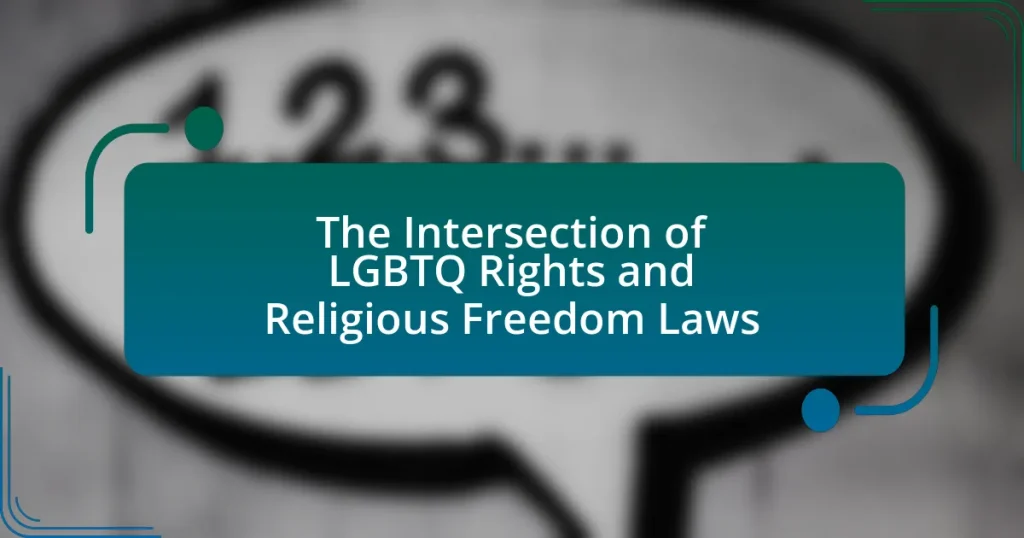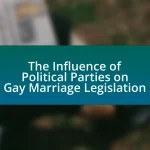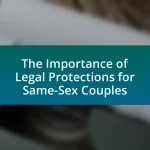The article examines the intersection of LGBTQ rights and religious freedom laws, highlighting the legal and social tensions that arise when anti-discrimination protections for LGBTQ individuals conflict with the rights of individuals or organizations to exercise their religious beliefs. Key principles of LGBTQ rights, such as equality and non-discrimination, are contrasted with foundational aspects of religious freedom laws, which protect individuals’ rights to practice their religion without government interference. The discussion includes significant legal cases, such as Masterpiece Cakeshop v. Colorado Civil Rights Commission and Obergefell v. Hodges, as well as the implications of varying state laws and international perspectives on this complex issue. The article also addresses the social consequences of these conflicts and suggests strategies for promoting understanding and coexistence between the two rights.
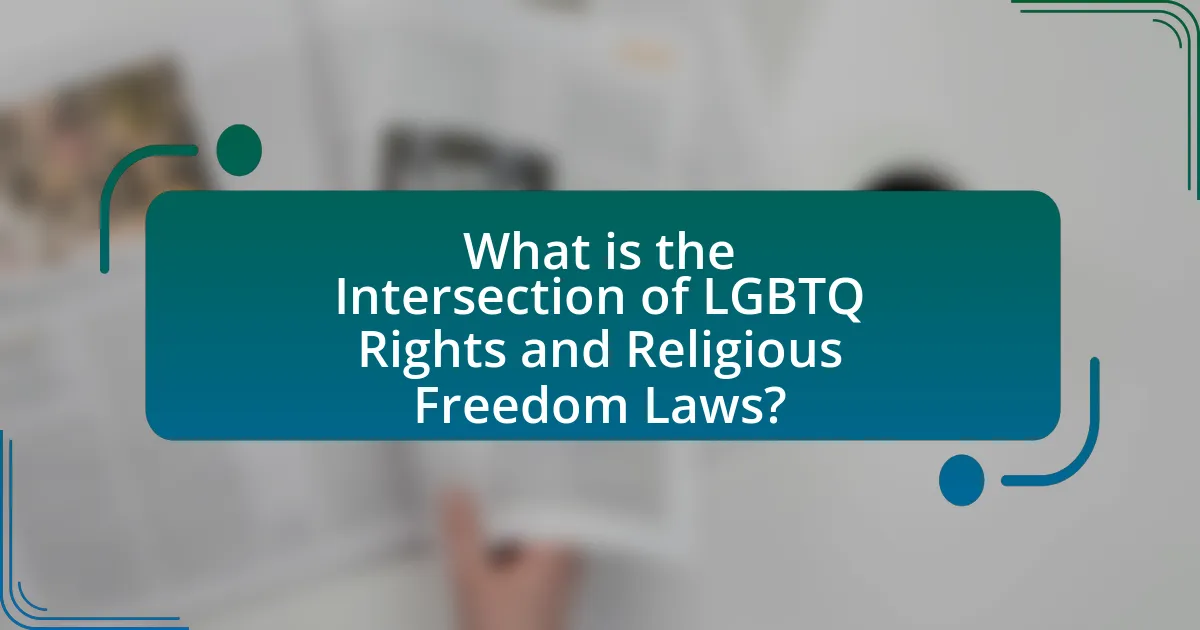
What is the Intersection of LGBTQ Rights and Religious Freedom Laws?
The intersection of LGBTQ rights and religious freedom laws involves the legal and social tensions between protecting LGBTQ individuals from discrimination and allowing individuals or organizations to exercise their religious beliefs. In many jurisdictions, LGBTQ rights are protected under anti-discrimination laws, which can conflict with religious freedom laws that permit individuals or entities to refuse services based on their religious beliefs. For example, cases like Masterpiece Cakeshop v. Colorado Civil Rights Commission highlight this conflict, where a baker refused to create a wedding cake for a same-sex couple citing religious beliefs, leading to a legal battle over the balance between LGBTQ rights and religious freedom. This intersection continues to evolve as courts and legislatures address these competing rights.
How do LGBTQ rights and religious freedom laws interact?
LGBTQ rights and religious freedom laws often interact in complex ways, leading to legal and social conflicts. In many jurisdictions, laws protecting LGBTQ individuals from discrimination can clash with laws that allow individuals or organizations to refuse services based on religious beliefs. For example, the U.S. Supreme Court case Masterpiece Cakeshop v. Colorado Civil Rights Commission (2018) highlighted this tension, where a baker refused to create a wedding cake for a same-sex couple citing religious objections, raising questions about the balance between anti-discrimination protections and religious liberties. This interaction continues to evolve as courts and legislatures address the competing rights of LGBTQ individuals and those claiming religious freedom.
What are the key principles of LGBTQ rights?
The key principles of LGBTQ rights include equality, non-discrimination, and the right to love and express one’s identity freely. Equality ensures that LGBTQ individuals have the same legal rights and protections as heterosexual individuals, as established in various international human rights treaties, such as the Universal Declaration of Human Rights. Non-discrimination prohibits unfair treatment based on sexual orientation or gender identity, which is supported by legal frameworks in many countries, including anti-discrimination laws in the United States. The right to love and express one’s identity freely is recognized in landmark court cases, such as Obergefell v. Hodges, which legalized same-sex marriage in the U.S., affirming that love and partnership should not be restricted by sexual orientation.
What are the foundational aspects of religious freedom laws?
The foundational aspects of religious freedom laws include the protection of individuals’ rights to practice their religion freely without government interference. These laws are grounded in constitutional principles, such as the First Amendment of the United States Constitution, which guarantees the free exercise of religion and prohibits the establishment of religion by the state. Additionally, religious freedom laws often aim to balance the rights of religious individuals or organizations with the rights of others, including those in the LGBTQ community, by providing exemptions or accommodations in certain circumstances. This balance is crucial in legal cases, such as Burwell v. Hobby Lobby Stores, Inc., where the Supreme Court recognized the rights of closely held corporations to refuse to provide contraceptive coverage based on religious beliefs, illustrating the ongoing tension between religious freedom and other civil rights.
Why is the intersection of these rights significant?
The intersection of LGBTQ rights and religious freedom laws is significant because it highlights the ongoing conflict between individual rights and collective beliefs. This intersection raises critical legal and ethical questions about how to balance the rights of LGBTQ individuals to live free from discrimination with the rights of individuals and organizations to practice their religious beliefs. For instance, cases such as Masterpiece Cakeshop v. Colorado Civil Rights Commission illustrate how courts navigate these tensions, emphasizing the need for legal frameworks that protect both sets of rights while ensuring that discrimination does not occur. The significance lies in the potential for legal precedents to shape societal norms and influence future legislation regarding equality and religious expression.
How does this intersection impact individuals and communities?
The intersection of LGBTQ rights and religious freedom laws significantly impacts individuals and communities by creating legal and social tensions that can lead to discrimination or protection, depending on the context. For instance, in jurisdictions where religious freedom laws allow individuals or businesses to refuse services to LGBTQ individuals based on religious beliefs, this can result in systemic discrimination against LGBTQ people, limiting their access to essential services such as healthcare, housing, and employment. A study by the Williams Institute found that 42% of LGBTQ individuals reported experiencing discrimination in public accommodations, highlighting the real-world consequences of such legal frameworks. Conversely, in areas where LGBTQ rights are protected, individuals experience greater acceptance and equality, fostering inclusive communities that benefit from diversity.
What historical events have shaped this intersection?
The historical events that have shaped the intersection of LGBTQ rights and religious freedom laws include the Stonewall Riots of 1969, which marked a significant turning point in the LGBTQ rights movement, leading to increased visibility and advocacy for LGBTQ individuals. Additionally, the passage of the Religious Freedom Restoration Act in 1993 established a legal framework that allowed individuals to assert religious beliefs in opposition to certain laws, including those protecting LGBTQ rights. The Supreme Court’s decision in Obergefell v. Hodges in 2015, which legalized same-sex marriage nationwide, further intensified the debate between LGBTQ rights and religious freedom, as it prompted discussions about the rights of religious organizations to refuse services based on their beliefs. These events collectively illustrate the ongoing tension and dialogue between the pursuit of LGBTQ rights and the assertion of religious freedoms in the United States.
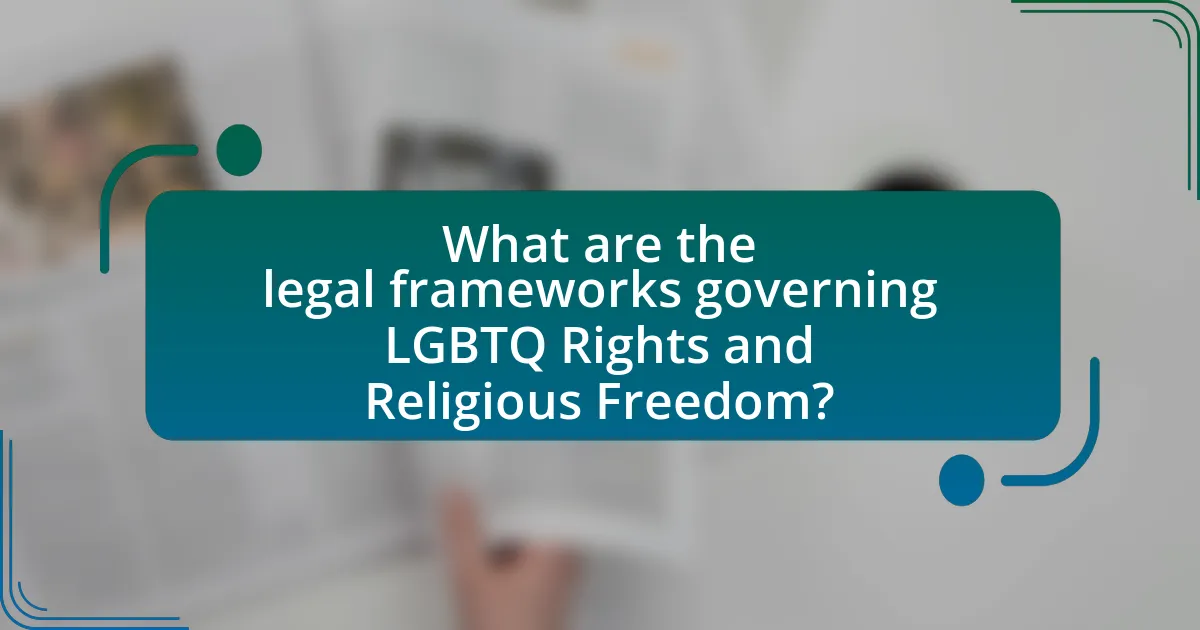
What are the legal frameworks governing LGBTQ Rights and Religious Freedom?
The legal frameworks governing LGBTQ rights and religious freedom vary significantly across jurisdictions, often reflecting a tension between anti-discrimination laws and religious liberty protections. In the United States, for example, the Civil Rights Act of 1964 prohibits discrimination based on sex, which has been interpreted by courts to include sexual orientation and gender identity, thereby providing a legal basis for LGBTQ rights. Conversely, the Religious Freedom Restoration Act (RFRA) allows individuals and organizations to assert religious beliefs as a defense in legal proceedings, which can lead to conflicts with LGBTQ rights, particularly in cases involving service provision and employment.
Internationally, various treaties and conventions, such as the International Covenant on Civil and Political Rights, advocate for non-discrimination based on sexual orientation, while some countries have constitutional provisions that protect religious freedom, creating a complex legal landscape. For instance, in countries like Canada, the Charter of Rights and Freedoms protects both LGBTQ rights and religious freedoms, but the application of these rights can lead to legal disputes, as seen in cases involving religious organizations that oppose same-sex marriage.
What major laws and court cases influence this intersection?
Major laws and court cases influencing the intersection of LGBTQ rights and religious freedom include the Religious Freedom Restoration Act (RFRA) of 1993, which protects individuals’ religious practices, and the Supreme Court case Obergefell v. Hodges (2015), which legalized same-sex marriage nationwide. The RFRA allows individuals to challenge laws that substantially burden their religious exercise, impacting cases where businesses refuse services based on religious beliefs. Obergefell v. Hodges established that same-sex couples have the constitutional right to marry, thereby affirming LGBTQ rights. These legal frameworks create ongoing debates and conflicts between religious freedom and LGBTQ rights, shaping policies and court rulings across the United States.
How do federal laws address LGBTQ rights?
Federal laws address LGBTQ rights primarily through anti-discrimination protections and marriage equality. The landmark Supreme Court case Obergefell v. Hodges in 2015 established that same-sex marriage is a constitutional right under the Fourteenth Amendment, ensuring legal recognition and benefits for same-sex couples. Additionally, the Civil Rights Act of 1964 has been interpreted by the Supreme Court to include protections against discrimination based on sexual orientation and gender identity, as seen in the 2020 case Bostock v. Clayton County. This ruling confirmed that firing someone for being LGBTQ constitutes sex discrimination, thereby extending federal protections to LGBTQ individuals in employment.
What state-level variations exist in religious freedom laws?
State-level variations in religious freedom laws include differences in the extent of protections offered to individuals and organizations based on their religious beliefs. For instance, some states, like Indiana and Arkansas, have enacted Religious Freedom Restoration Acts (RFRAs) that allow individuals to challenge laws that substantially burden their religious exercise, while other states have more limited or no such protections. Additionally, states like California and New York have laws that explicitly prohibit discrimination based on sexual orientation and gender identity, which can conflict with religious freedom claims. These variations reflect differing state priorities and interpretations of the balance between religious liberty and anti-discrimination protections, as evidenced by legal cases and legislative actions across the country.
How do different jurisdictions approach this intersection?
Different jurisdictions approach the intersection of LGBTQ rights and religious freedom laws in varied ways, often reflecting their cultural, legal, and political contexts. For instance, in the United States, some states have enacted laws that protect LGBTQ rights while simultaneously allowing for religious exemptions, such as the Religious Freedom Restoration Act in Indiana, which permits individuals and businesses to refuse services based on religious beliefs. Conversely, states like California have implemented comprehensive anti-discrimination laws that prioritize LGBTQ rights over religious objections, creating a more inclusive legal framework. Internationally, countries like Canada have robust protections for LGBTQ individuals, with laws that explicitly prohibit discrimination based on sexual orientation and gender identity, while some nations maintain laws that criminalize LGBTQ identities under the guise of religious or cultural norms. These varying approaches illustrate the complex legal landscape where LGBTQ rights and religious freedoms intersect, influenced by local values and legal precedents.
What are the implications of varying state laws on LGBTQ rights?
Varying state laws on LGBTQ rights create a patchwork of protections and restrictions that significantly impact the lives of LGBTQ individuals. For instance, states like California and New York have comprehensive anti-discrimination laws that protect LGBTQ individuals in employment, housing, and public accommodations, while states such as Alabama and Arkansas have enacted laws that allow discrimination based on sexual orientation and gender identity under the guise of religious freedom. This inconsistency leads to unequal access to rights and services, contributing to disparities in mental health, economic stability, and overall well-being among LGBTQ populations. According to the Human Rights Campaign, states with fewer protections report higher rates of discrimination and violence against LGBTQ individuals, highlighting the real-world consequences of these legal variations.
How do international perspectives differ on this issue?
International perspectives on the intersection of LGBTQ rights and religious freedom laws vary significantly, reflecting cultural, legal, and social differences. In many Western countries, such as Canada and the Netherlands, there is a strong emphasis on protecting LGBTQ rights, often prioritizing them over religious exemptions. For instance, Canada’s Bill C-16 explicitly prohibits discrimination based on gender identity and expression, showcasing a legal framework that supports LGBTQ individuals.
Conversely, in several Middle Eastern and African nations, religious beliefs heavily influence laws, often resulting in the criminalization of LGBTQ identities. Countries like Saudi Arabia and Uganda enforce strict anti-LGBTQ laws, citing religious doctrines as justification for these policies. This stark contrast highlights how cultural and religious contexts shape the legal landscape regarding LGBTQ rights globally.
Additionally, international organizations like the United Nations advocate for LGBTQ rights, yet member states exhibit diverse compliance levels, further illustrating the disparity in perspectives. For example, while the UN Human Rights Council has passed resolutions supporting LGBTQ rights, countries like Russia and Poland have resisted these initiatives, emphasizing national sovereignty and traditional values.
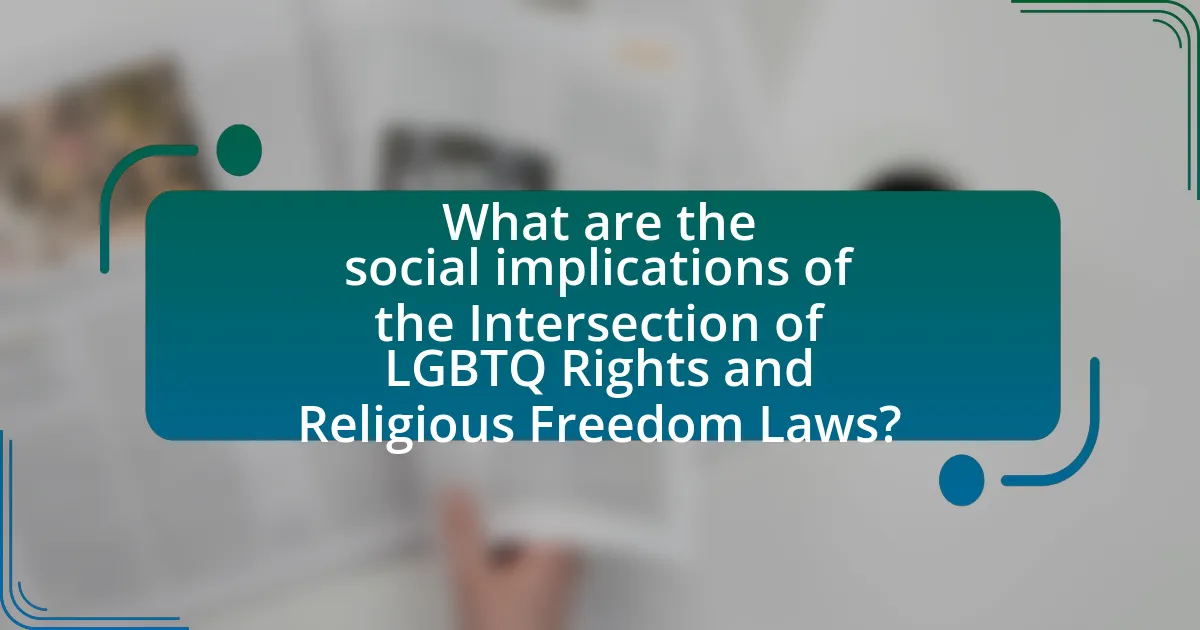
What are the social implications of the Intersection of LGBTQ Rights and Religious Freedom Laws?
The intersection of LGBTQ rights and religious freedom laws creates significant social implications, primarily involving conflicts between individual rights and collective beliefs. These conflicts often lead to societal polarization, where LGBTQ individuals may face discrimination under the guise of religious liberty, as seen in cases where businesses refuse services based on sexual orientation. For instance, the Supreme Court case Masterpiece Cakeshop v. Colorado Civil Rights Commission highlighted this tension, illustrating how religious beliefs can clash with anti-discrimination protections for LGBTQ individuals. Additionally, such legal frameworks can foster environments of intolerance, impacting mental health and social acceptance within communities. The ongoing debates around these issues reflect broader societal struggles over equality, freedom, and the role of religion in public life.
How do societal attitudes shape the debate on this intersection?
Societal attitudes significantly influence the debate on the intersection of LGBTQ rights and religious freedom laws by framing public perception and policy discussions. For instance, in regions where acceptance of LGBTQ individuals is high, there tends to be stronger advocacy for laws that protect LGBTQ rights, often leading to pushback against religious exemptions that may discriminate against these individuals. Conversely, in areas with prevalent conservative or traditional views, religious freedom laws are often prioritized, allowing individuals and organizations to refuse services based on their beliefs, which can infringe upon LGBTQ rights. This dynamic is evidenced by surveys indicating that 70% of Americans support anti-discrimination protections for LGBTQ individuals, while only 30% believe that religious beliefs should allow for discrimination against them. Thus, societal attitudes directly shape legislative outcomes and the overall discourse surrounding this intersection.
What role do religious organizations play in this discourse?
Religious organizations play a significant role in the discourse surrounding LGBTQ rights and religious freedom laws by influencing public opinion and policy through advocacy and interpretation of religious texts. These organizations often assert that their religious beliefs should allow them to refuse services or employment to LGBTQ individuals, framing their stance as a matter of religious freedom. For instance, in the United States, cases like Masterpiece Cakeshop v. Colorado Civil Rights Commission highlight how religious organizations argue for the right to act according to their beliefs, impacting legal interpretations and societal norms. This dynamic illustrates the tension between protecting LGBTQ rights and upholding religious liberties, making religious organizations key players in shaping the ongoing debate.
How do LGBTQ advocacy groups respond to religious freedom claims?
LGBTQ advocacy groups typically respond to religious freedom claims by asserting that such claims should not be used to justify discrimination against LGBTQ individuals. These groups argue that religious freedom should not infringe upon the civil rights of others, emphasizing that laws protecting LGBTQ rights are essential for ensuring equality and preventing harm. For instance, the Human Rights Campaign has stated that allowing religious exemptions can lead to systemic discrimination, undermining the progress made in LGBTQ rights. This perspective is supported by legal precedents where courts have ruled that anti-discrimination laws take precedence over religious beliefs when they conflict.
What are the potential consequences of conflicts between these rights?
Conflicts between LGBTQ rights and religious freedom laws can lead to significant legal, social, and economic consequences. Legally, such conflicts may result in court cases that challenge the validity of laws protecting one group over the other, as seen in cases like Masterpiece Cakeshop v. Colorado Civil Rights Commission, where the U.S. Supreme Court addressed the balance between religious beliefs and anti-discrimination laws. Socially, these conflicts can exacerbate divisions within communities, leading to increased discrimination or hostility towards LGBTQ individuals, as evidenced by surveys indicating heightened mental health issues among LGBTQ populations in areas with restrictive laws. Economically, businesses may face backlash or boycotts depending on their stance regarding these rights, impacting their profitability and public image, as demonstrated by the economic repercussions faced by states that have enacted discriminatory laws.
How can these conflicts affect public policy and community relations?
Conflicts between LGBTQ rights and religious freedom laws can significantly influence public policy and community relations by creating polarization among different societal groups. These conflicts often lead to legislative debates where policymakers must balance the rights of LGBTQ individuals with the religious beliefs of certain communities. For instance, in the United States, the introduction of laws that protect LGBTQ rights has prompted pushback from religious organizations, resulting in policies that may either strengthen anti-discrimination protections or allow for religious exemptions. This dynamic can foster mistrust and division within communities, as seen in cases like the Masterpiece Cakeshop v. Colorado Civil Rights Commission, where the Supreme Court’s ruling highlighted the tension between individual rights and religious freedoms. Consequently, public policy becomes a reflection of these societal conflicts, impacting community relations by either bridging gaps through inclusive policies or deepening divides through contentious legislation.
What strategies can be employed to navigate these conflicts?
To navigate conflicts between LGBTQ rights and religious freedom laws, strategies such as dialogue facilitation, legal mediation, and policy development can be employed. Dialogue facilitation encourages open communication between conflicting parties, allowing for mutual understanding and respect. Legal mediation provides a structured environment where disputes can be resolved amicably, often leading to compromises that honor both LGBTQ rights and religious beliefs. Policy development involves creating inclusive laws that protect both LGBTQ individuals and religious freedoms, ensuring that neither group is marginalized. These strategies have been supported by various studies, including the 2019 report by the American Psychological Association, which highlights the effectiveness of mediation in resolving conflicts related to civil rights and religious liberties.
What best practices can be adopted to promote understanding and coexistence?
Promoting understanding and coexistence between LGBTQ rights and religious freedom requires implementing inclusive dialogue initiatives. These initiatives can include community forums that encourage open discussions, allowing individuals from both perspectives to share their experiences and beliefs. Research shows that such dialogues can reduce prejudice and foster empathy, as evidenced by a study published in the Journal of Social Issues, which found that structured conversations significantly improved attitudes toward marginalized groups. Additionally, educational programs that highlight the importance of both LGBTQ rights and religious freedoms can create a more informed public, leading to greater acceptance and coexistence.
